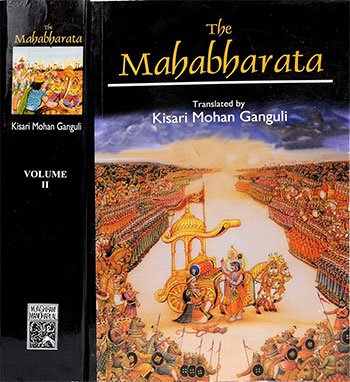Section CCLXXXI - Rama's Army March to Lanka: Building Nala's Bridge
Book index: Mahabharata (English)
This page contains a summary of the Mahabharata Section CCLXXXI including examples of moral lessons in daily life. The Maha-Bharata is one of the largest epics ever written containing roughly 100,000 Sanskrit verses. It deals with the legendary history of ancient India and contains a large number of interwoven tales.
Short summary of the chapter:
In the story, Rama and his army of monkeys, led by Sugriva, gathered on a hill to prepare for battle against Ravana. Various monkey chiefs, including Gaya, Gavakshya, and Hanuman, brought together a massive army of monkeys to support Rama. The monkey army, vast in numbers and strength, marched towards the sea to reach Lanka, where Ravana resided. Along the way, Rama and his army faced the challenge of crossing the vast ocean to reach their destination.
Rama sought a way to cross the ocean and prayed to the Ocean deity for assistance. The Ocean appeared before Rama and agreed to help, advising him to have Nala, a skilled monkey, build a bridge over the sea. With Nala's expertise, a bridge of ten Yojanas in width and a hundred Yojanas in length was constructed, known as Nala's bridge. Rama's army crossed the bridge, with Nala eventually returning after completing his task. This feat allowed Rama and his army to continue their journey towards Lanka.
Meanwhile, Vibhishana, Ravana's virtuous brother, approached Rama and pledged his allegiance. Initially met with suspicion from Sugriva, Vibhishana proved his loyalty to Rama, who welcomed him warmly. Rama appointed Vibhishana as the ruler of the Rakshasas and a trusted advisor, aiding in their journey to Lanka. With Vibhishana's guidance, Rama's army successfully crossed the ocean and began their attack on Lanka, devastating its gardens and preparing for the final battle against Ravana.
During their time in Lanka, Rama's army encountered two spies, Suka and Sarana, who had assumed the form of monkeys. Vibhishana detected their true identities as Rakshasas, and Rama showed them the strength of his army before sending them back to Ravana. As they prepared for battle, Rama sent Angada as his envoy to deliver a message to Ravana, setting the stage for the ultimate confrontation between Rama and the ten-headed demon king. The stage is set for the epic battle that will determine the fate of the kingdom and its inhabitants.
Full English translation:
This page is merely a summary which is automatically generated. If you are looking for authentic sources such as the Sanskrit text or the Full English translation of Mahabharata Section CCLXXXI - Rama's Army March to Lanka: Building Nala's Bridge, have a look at the following articles:
Section CCLXXXI, online text
English translation by Kisari Mohan Ganguli.
Read this and other chapters online.
Mahabharata (English Summary)
by Kisari Mohan Ganguli | ISBN-10: 8121505933
Buy the latest edition:
FAQ of Mahabharata, Section CCLXXXI:
How did Rama's army plan to cross the ocean to reach Lanka?
Rama prayed to the Ocean for a way and built a bridge with Nala's help.
Who was Vibhishana and how did Rama treat him?
Vibhishana was a virtuous Rakshasa who helped Rama and was made a counsellor.
What happened to the spies Suka and Sarana sent by Ravana?
They were caught by Vibhishana, revealed their true forms, and were dismissed.
Why did Rama send Angada as an envoy to Ravana?
Angada was sent to deliver a message to Ravana before the battle.
Daily life: Rama's Army March to Lanka: Building Nala's Bridge:
The story shared above from an ancient epic portrays a tale of determination, teamwork, and strategic thinking. In our daily lives, we can draw inspiration from Rama and his allies as they embark on a formidable task, showing us the importance of facing challenges head-on. By breaking down seemingly insurmountable obstacles, like crossing the ocean, into manageable tasks and seeking innovative solutions, we learn the value of creative problem-solving.
Rama's approach to seeking help, showing respect, and uniting a diverse team of allies, including monkeys and bears, emphasizes the strength found in collaboration. Just as Rama did, we too can accomplish more by working together with others, drawing on each person’s unique strengths and abilities. By fostering a spirit of cooperation and respect in our interactions, we create a supportive environment where everyone contributes their best.
Moreover, the story illustrates the significance of patience and perseverance. Rama's decision to perform a peaceful act to seek guidance instead of resorting to violence immediately teaches us the power of patience and waiting for the right moment. Sometimes, in our haste to achieve our goals, we may choose quick fixes that are not sustainable. Rama’s methodical approach encourages us to think long-term and stay committed, even when progress seems slow.
Lastly, the inclusion of Vibhishana, a supposed enemy, into Rama’s circle highlights the importance of forgiveness and trust. By judging Vibhishana by his actions and intentions rather than his background, Rama exemplifies how being open-minded and trusting can lead to valuable alliances. In daily life, being receptive to others and viewing situations with an open heart can lead to unexpected support and opportunities.
